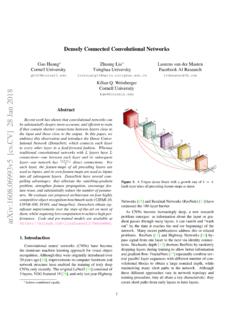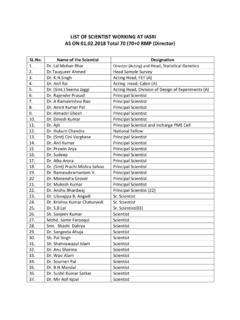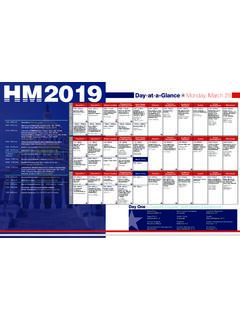Transcription of Going deeper with convolutions - arXiv
1 Going deeper with convolutionsChristian SzegedyGoogle LiuUniversity of North Carolina, Chapel HillYangqing JiaGoogle SermanetGoogle ReedUniversity of MichiganDragomir AnguelovGoogle ErhanGoogle VanhouckeGoogle RabinovichGoogle propose a deep convolutional neural network architecture codenamed Incep-tion, which was responsible for setting the new state of the art for classificationand detection in the ImageNet Large-Scale Visual Recognition Challenge 2014(ILSVRC14). The main hallmark of this architecture is the improved utilizationof the computing resources inside the network. This was achieved by a carefullycrafted design that allows for increasing the depth and width of the network whilekeeping the computational budget constant. To optimize quality, the architecturaldecisions were based on the Hebbian principle and the intuition of multi-scaleprocessing. One particular incarnation used in our submission for ILSVRC14 iscalled GoogLeNet, a 22 layers deep network, the quality of which is assessed inthe context of classification and IntroductionIn the last three years, mainly due to the advances of deep learning, more concretely convolutionalnetworks [10], the quality of image recognition and object detection has been progressing at a dra-matic pace.
2 One encouraging news is that most of this progress is not just the result of more powerfulhardware, larger datasets and bigger models, but mainly a consequence of new ideas, algorithms andimproved network architectures. No new data sources were used, for example, by the top entries inthe ILSVRC 2014 competition besides the classification dataset of the same competition for detec-tion purposes. Our GoogLeNet submission to ILSVRC 2014 actually uses12 fewer parametersthan the winning architecture of Krizhevsky et al [9] from two years ago, while being significantlymore accurate. The biggest gains in object-detection have not come from the utilization of deepnetworks alone or bigger models, but from the synergy of deep architectures and classical computervision, like the R-CNN algorithm by Girshick et al [6].Another notable factor is that with the ongoing traction of mobile and embedded computing, theefficiency of our algorithms especially their power and memory use gains importance.
3 It isnoteworthy that the considerations leading to the design of the deep architecture presented in thispaper included this factor rather than having a sheer fixation on accuracy numbers. For most of theexperiments, the models were designed to keep a computational budget multiply-addsat inference time, so that the they do not end up to be a purely academic curiosity, but could be putto real world use, even on large datasets, at a reasonable [ ] 17 Sep 2014In this paper, we will focus on an efficient deep neural network architecture for computer vision,codenamed Inception, which derives its name from the Network in network paper by Lin et al [12]in conjunction with the famous we need to go deeper internet meme [1]. In our case, the word deep is used in two different meanings: first of all, in the sense that we introduce a new level oforganization in the form of the Inception module and also in the more direct sense of increasednetwork depth.
4 In general, one can view the Inception model as a logical culmination of [12]while taking inspiration and guidance from the theoretical work by Arora et al [2]. The benefitsof the architecture are experimentally verified on the ILSVRC 2014 classification and detectionchallenges, on which it significantly outperforms the current state of the Related WorkStarting with LeNet-5 [10], convolutional neural networks (CNN) have typically had a standardstructure stacked convolutional layers (optionally followed by contrast normalization and max-pooling) are followed by one or more fully-connected layers. Variants of this basic design areprevalent in the image classification literature and have yielded the best results to-date on MNIST,CIFAR and most notably on the ImageNet classification challenge [9, 21]. For larger datasets suchas Imagenet, the recent trend has been to increase the number of layers [12] and layer size [21, 14],while using dropout [7] to address the problem of concerns that max-pooling layers result in loss of accurate spatial information, the sameconvolutional network architecture as [9] has also been successfully employed for localization [9,14], object detection [6, 14, 18, 5] and human pose estimation [19].
5 Inspired by a neurosciencemodel of the primate visual cortex, Serre et al. [15] use a series of fixed Gabor filters of different sizesin order to handle multiple scales, similarly to the Inception model. However, contrary to the fixed2-layer deep model of [15], all filters in the Inception model are learned. Furthermore, Inceptionlayers are repeated many times, leading to a 22-layer deep model in the case of the is an approach proposed by Lin et al. [12] in order to increase the representa-tional power of neural networks. When applied to convolutional layers, the method could be viewedas additional1 1convolutional layers followed typically by the rectified linear activation [9]. Thisenables it to be easily integrated in the current CNN pipelines. We use this approach heavily in ourarchitecture. However, in our setting,1 1convolutions have dual purpose: most critically, theyare used mainly as dimension reduction modules to remove computational bottlenecks, that wouldotherwise limit the size of our networks.
6 This allows for not just increasing the depth, but also thewidth of our networks without significant performance current leading approach for object detection is the Regions with Convolutional Neural Net-works (R-CNN) proposed by Girshick et al. [6]. R-CNN decomposes the overall detection probleminto two subproblems: to first utilize low-level cues such as color and superpixel consistency forpotential object proposals in a category-agnostic fashion, and to then use CNN classifiers to identifyobject categories at those locations. Such a two stage approach leverages the accuracy of bound-ing box segmentation with low-level cues, as well as the highly powerful classification power ofstate-of-the-art CNNs. We adopted a similar pipeline in our detection submissions, but have ex-plored enhancements in both stages, such as multi-box [5] prediction for higher object boundingbox recall, and ensemble approaches for better categorization of bounding box Motivation and High Level ConsiderationsThe most straightforward way of improving the performance of deep neural networks is by increas-ing their size.
7 This includes both increasing the depth the number of levels of the network and itswidth: the number of units at each level. This is as an easy and safe way of training higher qualitymodels, especially given the availability of a large amount of labeled training data. However thissimple solution comes with two major size typically means a larger number of parameters, which makes the enlarged network moreprone to overfitting, especially if the number of labeled examples in the training set is can become a major bottleneck, since the creation of high quality training sets can be tricky2(a) Siberian husky(b) Eskimo dogFigure 1: Two distinct classes from the 1000 classes of the ILSVRC 2014 classification expensive, especially if expert human raters are necessary to distinguish between fine-grainedvisual categories like those in ImageNet (even in the 1000-class ILSVRC subset) as demonstratedby Figure drawback of uniformly increased network size is the dramatically increased use of compu-tational resources.
8 For example, in a deep vision network, if two convolutional layers are chained,any uniform increase in the number of their filters results in a quadratic increase of computation. Ifthe added capacity is used inefficiently (for example, if most weights end up to be close to zero),then a lot of computation is wasted. Since in practice the computational budget is always finite, anefficient distribution of computing resources is preferred to an indiscriminate increase of size, evenwhen the main objective is to increase the quality of fundamental way of solving both issues would be by ultimately moving from fully connectedto sparsely connected architectures, even inside the convolutions . Besides mimicking biologicalsystems, this would also have the advantage of firmer theoretical underpinnings due to the ground-breaking work of Arora et al. [2]. Their main result states that if the probability distribution ofthe data-set is representable by a large, very sparse deep neural network, then the optimal networktopology can be constructed layer by layer by analyzing the correlation statistics of the activationsof the last layer and clustering neurons with highly correlated outputs.
9 Although the strict math-ematical proof requires very strong conditions, the fact that this statement resonates with the wellknown Hebbian principle neurons that fire together, wire together suggests that the underlyingidea is applicable even under less strict conditions, in the downside, todays computing infrastructures are very inefficient when it comes to numericalcalculation on non-uniform sparse data structures. Even if the number of arithmetic operations isreduced by100 , the overhead of lookups and cache misses is so dominant that switching to sparsematrices would not pay off. The gap is widened even further by the use of steadily improving,highly tuned, numerical libraries that allow for extremely fast dense matrix multiplication, exploit-ing the minute details of the underlying CPU or GPU hardware [16, 9]. Also, non-uniform sparsemodels require more sophisticated engineering and computing infrastructure. Most current visionoriented machine learning systems utilize sparsity in the spatial domain just by the virtue of em-ploying convolutions .
10 However, convolutions are implemented as collections of dense connectionsto the patches in the earlier layer. ConvNets have traditionally used random and sparse connectiontables in the feature dimensions since [11] in order to break the symmetry and improve learning, thetrend changed back to full connections with [9] in order to better optimize parallel computing. Theuniformity of the structure and a large number of filters and greater batch size allow for utilizingefficient dense raises the question whether there is any hope for a next, intermediate step: an architecturethat makes use of the extra sparsity, even at filter level, as suggested by the theory, but exploits our3current hardware by utilizing computations on dense matrices. The vast literature on sparse matrixcomputations ( [3]) suggests that clustering sparse matrices into relatively dense submatricestends to give state of the art practical performance for sparse matrix multiplication.
![arXiv:0706.3639v1 [cs.AI] 25 Jun 2007](/cache/preview/4/1/3/9/3/1/4/b/thumb-4139314b93ef86b7b4c2d05ebcc88e46.jpg)

![arXiv:1301.3781v3 [cs.CL] 7 Sep 2013](/cache/preview/4/d/5/0/4/3/4/0/thumb-4d504340120163c0bdf3f4678d8d217f.jpg)
![@google.com arXiv:1609.03499v2 [cs.SD] 19 Sep 2016](/cache/preview/c/3/4/9/4/6/9/b/thumb-c349469b499107d21e221f2ac908f8b2.jpg)










